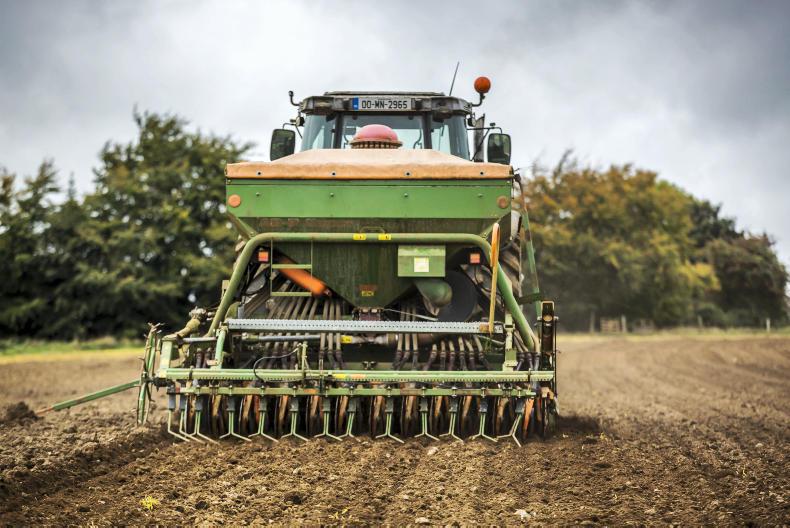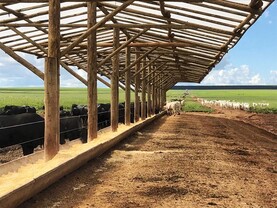Sowing is nearing completion following ideal conditions this autumn. Virtually all maize ground is now sown, and crops continue to be planted following potato and beet harvesting. In comparison with 2018 levels, winter crops have increased, largely driven by winter barley. However, with a higher amount of home-save seed sown this year and with lower grain weights stretching seed further, accurate area assessments are difficult.

Winter barley around 70,000ha
Winter barley area is expected to increase 25-30% on 2018 levels, according to reports from growers and seed sales reports from members of the trade.
Winter barley was the star performer in 2018, largely due to many other crops suffering from the effects of the drought. Reasonable grain and good straw yields, coupled with high prices, reduced the premium of wheat over barley and under-preforming spring crops made the decision to increase winter barley easy for many growers.
Reports from the ground suggest winter barley is replacing second and third wheats in places and is being sown following spring crops. As a result, there has been a notable increase in sales of winter barley seed treated with Latitude.
With this increase in area, the 2019 winter barley crop is expected to surpass 70,000ha, similar to 2015 levels. Despite initial fears, it appears there was enough native winter barley seed this year to meet demand.
Winter wheat area
Winter wheat area is expected to increase somewhat on the 55,000ha planted in 2018. Reports suggest it could increase by as much as 10% in key wheat growing areas in the northeast. There was a marked increase in maize crops in these areas this year, which explains some of the increase in winter wheat for 2019. But there will be area reductions in other regions.
Reports suggest increased barley area following break crops in some areas. This, plus the fact that barley is also replacing second and third wheats and that there were less break crops planted in parts of the south in 2018, are the main reasons for reduced wheat planting in some areas further south.
However, winter wheat planting is ongoing and the area planted following maize, potatoes and beet is, as yet, unknown.
Winter oat area
Reports indicate that winter oat area is expected to increase slightly on 2018 levels. Some growers have opted to plant winter oats following a spring cereal which was intended as a break crop last spring. Others are choosing to sow winter oats instead of a 2019 spring break crop.
There was much talk on the ground with regard to oat seed availability but reports suggest that, by and large, seed supply met demand this year. Thousand grain weights were particularly low on oats which helped stretch seed this year.
However spring oat planting in 2019 is likely be a different matter. Reduced oat area and yields in 2018 due to the late spring, drought and suspension of the three-crop rule, meant that 2019 spring seed supply could come under pressure.
The shortfall may be met with seed imports but acquiring suitable varieties may prove a challenge. Sweden, Finland and Australia, three of the top five oat exporters which account for 90% of global oat exports, will see declines in exports ranging from 15-61% this year.
Beans and oilseed rape
The 2019 winter bean area is expected to fall, with growers citing seed supply as a major issue this year. A slight increase in winter oilseed rape area is also expected. 2019 winter oilseed area may return to more normal levels, close to 8,000ha.
Read more
Winter grain acreage up as conditions remain ideal
Tillage management: complete autumn husbandry once planting is finished
Sowing is nearing completion following ideal conditions this autumn. Virtually all maize ground is now sown, and crops continue to be planted following potato and beet harvesting. In comparison with 2018 levels, winter crops have increased, largely driven by winter barley. However, with a higher amount of home-save seed sown this year and with lower grain weights stretching seed further, accurate area assessments are difficult.

Winter barley around 70,000ha
Winter barley area is expected to increase 25-30% on 2018 levels, according to reports from growers and seed sales reports from members of the trade.
Winter barley was the star performer in 2018, largely due to many other crops suffering from the effects of the drought. Reasonable grain and good straw yields, coupled with high prices, reduced the premium of wheat over barley and under-preforming spring crops made the decision to increase winter barley easy for many growers.
Reports from the ground suggest winter barley is replacing second and third wheats in places and is being sown following spring crops. As a result, there has been a notable increase in sales of winter barley seed treated with Latitude.
With this increase in area, the 2019 winter barley crop is expected to surpass 70,000ha, similar to 2015 levels. Despite initial fears, it appears there was enough native winter barley seed this year to meet demand.
Winter wheat area
Winter wheat area is expected to increase somewhat on the 55,000ha planted in 2018. Reports suggest it could increase by as much as 10% in key wheat growing areas in the northeast. There was a marked increase in maize crops in these areas this year, which explains some of the increase in winter wheat for 2019. But there will be area reductions in other regions.
Reports suggest increased barley area following break crops in some areas. This, plus the fact that barley is also replacing second and third wheats and that there were less break crops planted in parts of the south in 2018, are the main reasons for reduced wheat planting in some areas further south.
However, winter wheat planting is ongoing and the area planted following maize, potatoes and beet is, as yet, unknown.
Winter oat area
Reports indicate that winter oat area is expected to increase slightly on 2018 levels. Some growers have opted to plant winter oats following a spring cereal which was intended as a break crop last spring. Others are choosing to sow winter oats instead of a 2019 spring break crop.
There was much talk on the ground with regard to oat seed availability but reports suggest that, by and large, seed supply met demand this year. Thousand grain weights were particularly low on oats which helped stretch seed this year.
However spring oat planting in 2019 is likely be a different matter. Reduced oat area and yields in 2018 due to the late spring, drought and suspension of the three-crop rule, meant that 2019 spring seed supply could come under pressure.
The shortfall may be met with seed imports but acquiring suitable varieties may prove a challenge. Sweden, Finland and Australia, three of the top five oat exporters which account for 90% of global oat exports, will see declines in exports ranging from 15-61% this year.
Beans and oilseed rape
The 2019 winter bean area is expected to fall, with growers citing seed supply as a major issue this year. A slight increase in winter oilseed rape area is also expected. 2019 winter oilseed area may return to more normal levels, close to 8,000ha.
Read more
Winter grain acreage up as conditions remain ideal
Tillage management: complete autumn husbandry once planting is finished







 This is a subscriber-only article
This is a subscriber-only article










SHARING OPTIONS: